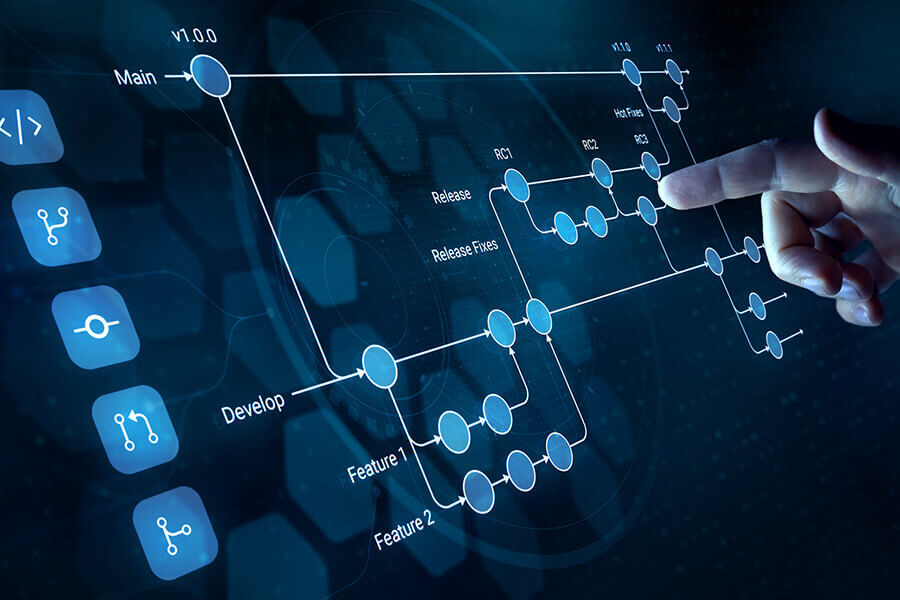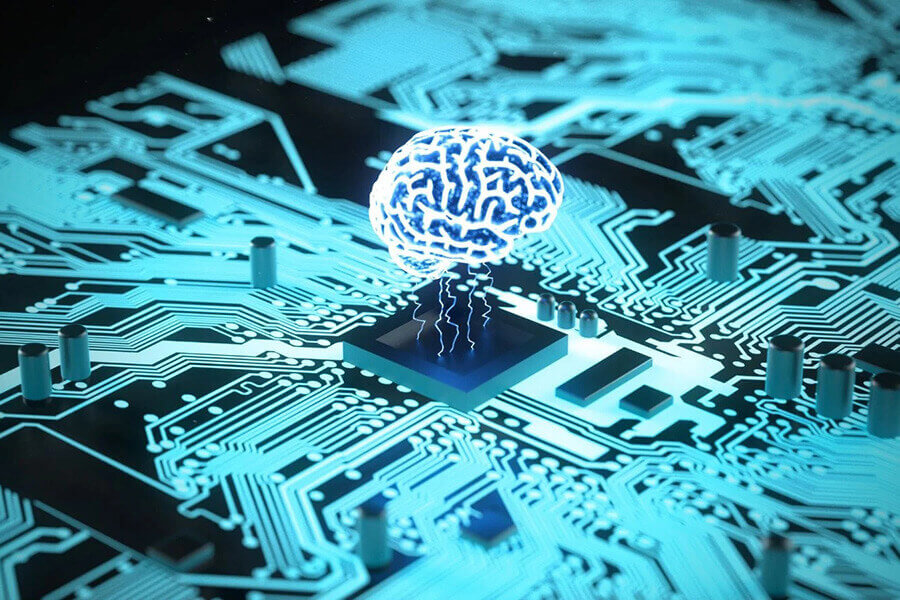Software Development Lifecycle: How AI Integration Transforms Modern Development Processes
Artificial intelligence is fundamentally transforming how software gets built, tested, and maintained across every stage of development. The traditional Software Development Lifecycle, once characterized by sequential phases and manual processes, is evolving into a more intelligent and automated system. AI-driven development streamlines SDLC by automating tasks, enhancing code quality, and accelerating delivery, making software creation faster, more innovative, and more efficient.
Organizations implementing AI-powered SDLC solutions are witnessing significant improvements in development speed and code quality. IBM and AWS report that their Generative AI-powered SDLC solution achieves up to 30% faster development time, a 25% improvement in code quality, and a 60% reduction in analysis phase time. These measurable benefits demonstrate AI’s practical impact on software development workflows.
The integration spans from initial planning and requirements analysis through coding, testing, deployment, and ongoing maintenance. AI tools are designed not to replace developers, but to amplify their impact and productivity across the entire software development lifecycle, freeing up engineering teams to focus on higher-value activities while automation handles repetitive tasks.
Understanding the Software Development Lifecycle in the Age of AI
The software development lifecycle has undergone a significant transformation as artificial intelligence reshapes traditional workflows and introduces new capabilities. AI tools are now being integrated across every phase of the SDLC, fundamentally changing how teams approach planning, development, testing, and deployment processes.
Traditional SDLC Overview
The conventional software development lifecycle consists of structured phases that guide project execution from concept to deployment. These phases typically include requirements gathering, system design, implementation, testing, deployment, and maintenance.
Planning and Requirements involve stakeholders defining project scope, functional specifications, and business objectives. Development teams analyze user needs and create detailed documentation outlining system requirements and constraints.
Design and Architecture focuses on creating system blueprints, database schemas, and user interface mockups. Engineers establish technical specifications, select appropriate technologies, and define integration points between system components.
Implementation and Coding represent the core development phase where programmers write source code according to established specifications. Teams follow coding standards, implement business logic, and create modular components that fulfill functional requirements.
Testing and Quality Assurance ensure software meets specified requirements through systematic validation processes. Quality assurance teams execute test cases, identify defects, and verify system functionality across different environments and use cases.
Deployment and Maintenance involve releasing software to production environments and providing ongoing support. DevOps teams manage infrastructure, monitor system performance, and implement updates to address bugs or feature requests.
Limitations of Conventional Development Workflows
Traditional SDLC approaches face several constraints that impact development speed, resource utilization, and project outcomes. Manual processes consume a significant amount of time and introduce human error throughout various development phases.
Resource-intensive manual Tasks require developers to spend substantial time on repetitive activities. Code reviews, documentation creation, and testing procedures often involve tedious manual work, which can reduce focus on creative problem-solving and innovation.
Sequential Dependencies create bottlenecks when teams must complete one phase before proceeding to the next. This waterfall approach limits flexibility and makes it difficult to adapt to changing requirements or market conditions during development.
Quality Assurance Challenges emerge from manual testing processes that cannot adequately cover all possible scenarios. Limited test coverage increases the risk of production bugs and security vulnerabilities that impact user experience.
Communication Gaps between development, operations, and business stakeholders often result in misaligned expectations. Poor collaboration leads to rework, delayed deliveries, and products that fail to meet actual user needs.
Emergence of AI in Software Engineering
Artificial intelligence has transformed software engineering by automating routine tasks and enhancing decision-making capabilities across development workflows. Organizations implementing AI-powered SDLC solutions report up to 30% faster development times and a 25% improvement in code quality.
Code Generation and Assistance tools help developers write code more efficiently through intelligent suggestions and automated completion. AI-powered IDEs analyze context, recommend best practices, and generate boilerplate code, thereby reducing development time and effort.
Automated Testing and Quality Assurance leverages machine learning algorithms to identify potential defects and generate comprehensive test cases. [AI tools can reduce analysis phase time by up to 60% while improving overall software reliability.
Predictive Analytics and Project Management enable teams to forecast development timelines, identify potential risks, and optimize resource allocation. AI algorithms analyze historical data to provide insights that improve project planning accuracy.
DevOps Integration and Deployment benefits from AI-driven automation that streamlines continuous integration and deployment processes. Machine learning models monitor system performance, predict failures, and automatically scale infrastructure based on demand patterns.
AI-Driven Evolution of SDLC Phases
Artificial intelligence is fundamentally transforming traditional software development phases through automation, intelligent analysis, and predictive capabilities. Machine learning algorithms now accelerate the gathering of requirements, streamline analysis workflows, and enhance design processes with unprecedented efficiency.
AI-Powered Planning and Requirement Gathering
AI transforms the planning phase by automating the extraction and analysis of requirements from multiple stakeholder inputs and, at the same time, processing complex business documents and user feedback.
Natural language processing algorithms parse unstructured requirements documents to identify key functional specifications. These systems extract actionable user stories from lengthy business requirements and stakeholder interviews, enabling more efficient development.
Key AI capabilities in planning include:
- Automated user story generation from business documents
- Requirement conflict detection through semantic analysis
- Stakeholder priority mapping using machine learning algorithms
- Gap analysis identification between the current and desired states
Machine learning models analyze historical project data to predict resource requirements and timeline estimates. They identify potential bottlenecks before project initiation based on similar past implementations.
AI assistants facilitate stakeholder collaboration by translating technical requirements into language that is business-friendly. This bridge reduces miscommunication between technical teams and business users during the critical planning phase.
Analysis Phase Transformation with Machine Learning
Machine learning revolutionizes the analysis phase by processing vast datasets and identifying patterns that human analysts might miss. Organizations achieve a 60% reduction in analysis phase time by using intelligent automation tools.
AI algorithms perform comprehensive code base analysis to understand the existing system architecture and dependencies. They automatically map complex relationships between different system components.
Machine learning enhances analysis through:
- Automated dependency mapping across system components
- Performance bottleneck identification using historical data
- Security vulnerability detection through pattern recognition
- Code complexity assessment with predictive analytics
Process optimization occurs through AI-powered workflow analysis that identifies redundant steps and suggests improvements. These systems analyze team productivity patterns to recommend optimal task allocation.
Natural language processing tools extract insights from technical documentation and legacy system specifications. They convert unstructured information into structured analysis reports for development teams.
AI-Enhanced Design and Prototyping
Artificial intelligence accelerates design workflows by generating user interface mockups and architectural blueprints from requirement specifications. AI tools create multiple design variations based on user experience best practices and accessibility standards.
Machine learning algorithms analyze user behavior data to suggest optimal user interface layouts and navigation flows. They predict user interaction patterns to inform design decisions early in the development cycle.
AI design capabilities include:
- Automated wireframe generation from functional requirements
- User interface optimization through behavioral analysis
- Accessibility compliance checking using machine learning models
- Responsive design adaptation across multiple device types
Generative AI creates interactive prototypes that stakeholders can test before development begins. These prototypes incorporate realistic data and workflows to provide accurate user experience previews.
AI-powered design systems maintain consistency across different application modules by enforcing style guidelines automatically. They detect design pattern violations and suggest corrections aligned with established brand standards.
Innovative prototyping tools integrate user feedback loops to improve design concepts iteratively. Machine learning algorithms process user testing data to recommend specific interface improvements and feature modifications.
Revolutionizing Development with AI-Assisted Coding
AI-assisted coding revolutionizes the way developers write, review, and maintain software by automating code generation, enhancing intelligent quality assurance, and facilitating seamless workflow integration. These advances reduce development time while improving code quality across entire project lifecycles.
Automated Code Generation and Completion
Large language models power sophisticated code generation tools that produce functional code from natural language descriptions. GitHub Copilot leads this transformation by suggesting entire functions, classes, and algorithms based on developer comments and context.
Developers experience significant productivity gains through intelligent autocompletion. The system analyzes existing code patterns and generates contextually appropriate suggestions. This reduces typing time and minimizes syntax errors.
Code snippets generated by AI tools often include best practices and optimized implementations. Developers can focus on high-level problem-solving rather than repetitive coding tasks. The technology adapts to individual coding styles and project requirements.
Popular AI coding assistants include:
- GitHub Copilot
- Amazon CodeWhisperer
- Tabnine
- IntelliCode
These tools integrate directly into development environments. They provide real-time suggestions that improve coding speed and accuracy.
Intelligent Code Reviews and Quality Assurance
AI-powered code reviews identify potential bugs, security vulnerabilities, and performance issues before deployment. These systems analyze code patterns against established best practices and flag problematic sections automatically.
Machine learning algorithms detect:
- Memory leaks
- SQL injection vulnerabilities
- Performance bottlenecks
- Code smells
- Compliance violations
Traditional code reviews require a significant amount of human time and expertise. AI tools provide instant feedback on code quality metrics. They maintain consistency across review standards and catch issues human reviewers might miss.
The technology learns from historical bug reports and security incidents. This knowledge base continuously improves detection accuracy. Development teams receive actionable recommendations for code improvements.
AI Tools Integration in Development Workflows
Modern development workflows incorporate AI tools at multiple stages of the software development lifecycle. Integration occurs seamlessly within existing IDEs, version control systems, and CI/CD pipelines.
Key integration points include:
| Stage | AI Application | Benefit |
| Planning | Requirement analysis | Improved specifications |
| Coding | Automated generation | Faster development |
| Testing | Bug detection | Higher quality |
| Deployment | Performance monitoring | Optimized releases |
Developers configure AI tools to match team preferences and project requirements. The tools learn from codebase patterns and adapt suggestions accordingly. This personalization improves relevance and adoption rates.
LLMs analyze project documentation and existing code to provide contextually relevant suggestions. They understand project architecture and coding standards. This deep integration reduces friction between AI assistance and human creativity.
Automation and Optimization in Testing and Deployment
AI transforms testing and deployment through intelligent automation that reduces manual effort while improving software quality. Machine learning algorithms enable predictive testing strategies and automated vulnerability detection that streamline CI/CD pipelines.
AI-Based Automated Testing Strategies
AI-powered testing tools enhance test automation through generative and predictive capabilities that create comprehensive test scenarios. These systems analyze code patterns to generate test cases automatically, reducing the time developers spend on manual test creation.
Machine learning algorithms examine historical testing data to identify high-risk areas of code. This approach enables teams to prioritize testing efforts on components most likely to contain defects.
Key AI Testing Capabilities:
- Intelligent test case generation based on code analysis
- Self-healing tests that adapt to UI changes automatically
- Performance prediction using historical execution data
- Risk-based testing that focuses on critical application areas
AI testing frameworks continuously learn from test execution results. They refine testing strategies over time, improving accuracy and reducing false positives that waste development resources.
Bug Detection and Vulnerability Management
AI systems excel at identifying bugs and security vulnerabilities through pattern recognition and anomaly detection. These tools continuously scan codebases, flagging potential issues before they reach production environments.
Machine learning models trained on vulnerability databases recognize security patterns across different programming languages. They identify common attack vectors, such as SQL injection, cross-site scripting, and buffer overflows, with high accuracy.
Automated Detection Features:
- Static code analysis for security vulnerabilities
- Runtime monitoring for performance anomalies
- Dependency scanning for third-party library risks
- Configuration assessment for deployment security
Advanced AI tools correlate multiple data sources to identify complex security threats. They analyze code commits, deployment patterns, and system behavior to detect sophisticated attack attempts that traditional tools miss.
Streamlined CI/CD and Deployment Processes
AI integration across SDLC stages speeds up workflows by automating deployment decisions and optimizing pipeline performance. Intelligent systems monitor build processes and automatically adjust resource allocation based on project requirements.
CI/CD pipelines enhanced with AI capabilities make deployment decisions based on code quality metrics, test coverage, and performance benchmarks. These systems can automatically roll back deployments when anomalies are detected.
Pipeline Optimization Benefits:
- Automated deployment approval based on quality gates
- Resource scaling that adjusts to build complexity
- Failure prediction that prevents problematic releases
- Performance monitoring with automatic remediation
AI-driven deployment systems analyze production metrics in real-time to optimize application performance. They automatically scale resources, route traffic, and implement configuration changes to maintain optimal system performance without human intervention.
Integrating Scalability and Maintenance Through AI
AI transforms how development teams approach system maintenance and scalability by automating monitoring tasks and predicting potential issues before they impact performance. Modern AI solutions enable proactive resource management and intelligent scaling decisions, reducing the need for manual intervention.
Predictive Maintenance and Monitoring
AI-powered predictive maintenance revolutionizes software monitoring by analyzing patterns in system behavior and performance metrics to optimize software maintenance. Machine learning algorithms identify anomalies in application performance, memory usage, and database queries before they escalate into critical failures.
Automated monitoring systems continuously track key performance indicators and generate alerts when deviations from these indicators occur. These systems learn from historical data to distinguish between normal fluctuations and genuine performance issues.
Key monitoring capabilities include:
- Real-time performance analysis
- Automated error detection
- Resource utilization forecasting
- User behavior pattern recognition
Development teams benefit from reduced downtime and faster issue resolution. AI systems can automatically trigger scaling actions or notify administrators when manual intervention becomes necessary.
Scalability Considerations with AI Solutions
AI-enabled software development allows organizations to build systems that automatically adjust to changing demand patterns. Cloud platforms integrate machine learning models that predict traffic spikes and allocate resources accordingly.
Horizontal and vertical scaling decisions become data-driven rather than reactive. AI analyzes user patterns, seasonal trends, and business metrics to recommend optimal resource configurations.
Scaling automation features:
- Load prediction: Forecasts traffic patterns based on historical data
- Resource optimization: Balances performance with cost efficiency
- Auto-scaling triggers: Adjusts capacity based on predefined thresholds
- Performance tuning: Optimizes database queries and caching strategies
IBM and other enterprise providers offer AI solutions that integrate directly with existing infrastructure. These platforms provide centralized dashboards for monitoring multiple applications and services simultaneously.
Real-World Applications and the Future of AI in SDLC
Major technology companies are implementing AI-driven platforms that deliver measurable improvements in development speed and code quality. Organizations are restructuring their traditional workflows to accommodate intelligent automation and AI-powered decision-making throughout the development process.
Case Studies: AI in Leading SDLC Platforms
IBM and AWS have created a generative AI-powered SDLC solution that demonstrates significant performance improvements across development phases. The platform integrates Amazon Bedrock’s capabilities to deliver concrete results for organizations.
Performance Metrics:
- 30% faster development time
- 25% improved code quality
- 60% reduction in analysis phase time
The solution is available through AWS Marketplace and brings standardization to every development stage. Teams can now automate routine tasks while maintaining quality standards.
AI platforms are reducing time spent in coding, testing, and documentation phases, leading to 30-50% faster software releases. These improvements come from intelligent code generation and automated testing processes.
Companies using these AI tools report faster time-to-market and reduced manual effort in repetitive development tasks. The platforms handle complex analysis while developers focus on strategic decisions.
Adapting Development Processes to AI Advances
Development teams are restructuring their workflows to integrate AI tools effectively throughout the SDLC. AI now spans the entire development process, from ideation through production support, making software delivery more context-aware and autonomous.
Key Process Changes:
- Requirements Phase: AI analyzes business needs and generates technical specifications
- Development Phase: Automated code generation from high-level descriptions
- Testing Phase: Intelligent test case creation and execution
- Deployment Phase: Automated monitoring and optimization
Organizations are training teams to work alongside AI systems rather than replacing human expertise. Developers now focus on business logic and requirements while AI handles implementation details.
Future AI systems will generate complete applications from descriptions, shifting human roles toward strategic planning and business alignment. Teams must adapt their skill sets to manage AI-assisted development effectively.
The transition requires new methodologies that strike a balance between human creativity and AI efficiency. Companies are establishing guidelines for integrating AI tools while maintaining code quality standards.
Conclusion
The integration of AI into the Software Development Lifecycle is no longer a distant vision—it is happening now, with measurable benefits reshaping how teams build and deliver software. By automating repetitive processes, enhancing accuracy, and providing real-time insights, AI empowers developers to focus on strategic and creative problem-solving rather than being bogged down by manual tasks. This transformation is redefining productivity standards and setting new expectations for development efficiency.
Yet, the real impact of AI in SDLC goes beyond faster timelines and cleaner code. It establishes a foundation for more adaptive, resilient, and innovative development processes that can evolve in response to shifting business demands. Organizations that adopt AI-driven SDLC are not only optimizing workflows; they are also future-proofing their software practices in an increasingly competitive market.
Ultimately, the successful integration of AI into SDLC will hinge on a balanced approach—leveraging automation where it drives value, while maintaining the human expertise and critical thinking that underpin innovation. For teams ready to adapt, AI offers a clear path toward more innovative development and long-term competitive advantage.








